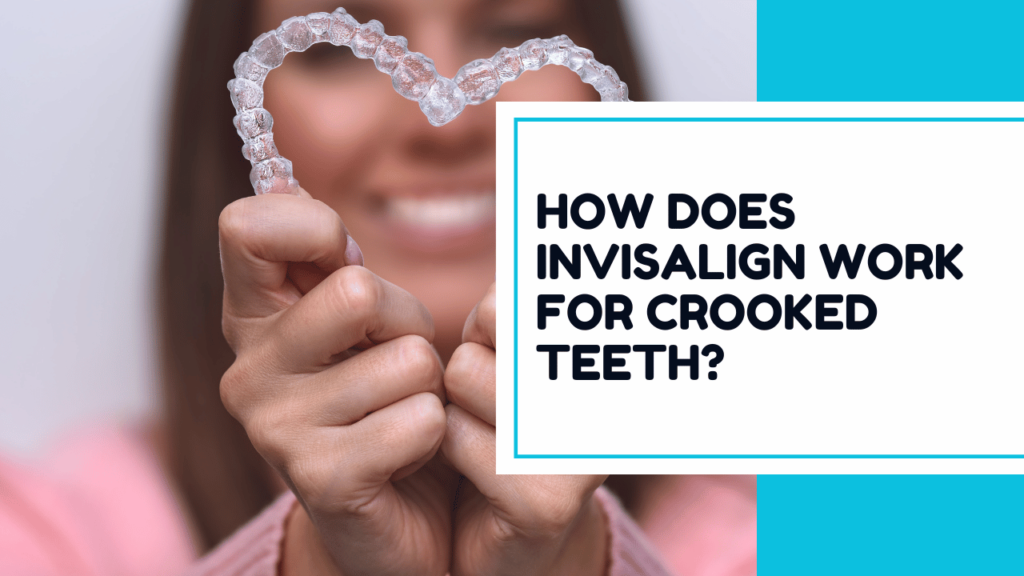Introduction
Invisalign, since its inception in the late 1990s, has remarkably evolved, becoming a popular choice in orthodontic treatment. Originally intended for minor dental adjustments, its capability has significantly broadened over time. This brings us to a commonly asked question among patients seeking orthodontic solutions: “How does Invisalign work for crooked teeth?”
Initially, there were doubts about whether Invisalign could effectively address the challenge of severely crooked teeth. Over the years, however, technological advancements in the field have greatly enhanced its scope. This progress has allowed Invisalign to confidently step into areas once thought beyond its reach, making it a suitable option for more complex orthodontic cases. The evolution of Invisalign from a treatment for minor dental misalignments to one that can handle significant orthodontic issues speaks volumes about its effectiveness and versatility. It’s a transformation that not only answers the critical question of its capability in treating crooked teeth but also highlights the significant strides made in modern dental technology.
Section 1: Understanding Invisalign and Its Functionality
Invisalign marks a significant departure from the traditional methods of orthodontics, introducing a novel way to align teeth. This method contrasts the older technique of metal brackets and wires. Invisalign employs a series of tailor-made, transparent plastic aligners that closely conform to the teeth’s shape. These aligners are crafted to progressively shift teeth to their correct positions. Offering a discreet and cosmetically appealing option, Invisalign has become a sought-after solution for those contemplating, “How does Invisalign work for crooked teeth?”
The journey to acquire Invisalign aligners is a personalized one, beginning with an in-depth consultation. During this phase, orthodontists evaluate the patient’s dental structure and discuss their specific goals, determining if Invisalign is an appropriate solution. The process progresses with the creation of 3D images and impressions of the patient’s dentition, which are essential in formulating aligners that perfectly align with the unique structure of each patient’s mouth.
The actual fitting of Invisalign involves the careful placement of tiny, tooth-colored composite dots or buttons on the teeth. These elements are crucial as they act as pivots, aiding the aligners in maneuvering the teeth to their new orientations. Patients are advised to wear their aligners for about 20 to 22 hours daily, removing them only during meals and dental care routines. As treatment progresses, patients receive successive sets of aligners, each incrementally moving the teeth closer to the desired alignment. This step-by-step process highlights the critical role of patient dedication and adherence in achieving the optimal results.
Invisalign’s blend of bespoke design, cutting-edge materials, and individualized treatment plans makes it a contemporary and efficient approach to addressing crooked teeth, charting a course towards a straighter and more self-assured smile.
Section 2: Evaluating Invisalign’s Effectiveness for Different Dental Conditions
Invisalign’s Versatility Across Various Levels of Teeth Misalignment
Invisalign’s capacity to correct teeth misalignment spans a broad spectrum, addressing everything from mild to certain severe dental irregularities. This capability provides a comprehensive answer to the query, “How does Invisalign work for crooked teeth?” Initially intended for less complex orthodontic issues, Invisalign has significantly evolved. Today, it caters to a wide array of dental conditions, effectively managing not only slight misalignments but also more complex orthodontic challenges. This adaptability has made Invisalign a preferred option for many, ensuring that most individuals seeking orthodontic correction can consider Invisalign as a viable and effective treatment option.
Advancements in Invisalign Technology Broadening Treatment Scope
The progression of Invisalign’s technology has been a key factor in enhancing its treatment scope. Innovations like the incorporation of attachments, buttons, and specialized features such as elastics and bite ramps have significantly improved Invisalign’s ability to handle complex dental issues. These technological strides have increased Invisalign’s control over tooth movement, leading to more precise and effective teeth alignment. As a result, even those dental cases previously deemed too challenging for Invisalign can now be successfully treated using this method. These advancements not only demonstrate Invisalign’s commitment to evolving with dental technology but also extend its capabilities to a wider range of dental misalignments, providing an effective and less invasive alternative to traditional orthodontic treatments.
Section 3: Comparing Invisalign with Traditional Braces
The Aesthetic and Comfort Edge of Invisalign
Invisalign’s clear, nearly invisible aligners provide a significant aesthetic advantage over traditional metal braces. This discreet nature of Invisalign aligners is a major draw for those questioning, “How does Invisalign work for crooked teeth?” Particularly appealing to adults and working professionals, Invisalign allows for orthodontic treatment without the noticeable appearance of metal brackets and wires. Alongside its aesthetic benefits, Invisalign aligners are known for their comfort. Crafted from smooth plastic, these aligners are custom-fitted to the wearer’s teeth, eliminating the irritation often caused by the metal components of traditional braces. This makes Invisalign a comfortable, less invasive option for individuals undergoing long-term orthodontic treatment.
Evaluating Cost and Insurance Coverage
When considering orthodontic treatment options, cost is a significant factor. Invisalign, in many cases, offers a cost-effective alternative to traditional braces. The actual cost can vary depending on the complexity and length of treatment, but it’s competitive with the costs of traditional orthodontics. Many dental insurance plans that cover braces also extend coverage to Invisalign treatments, making it a viable option for those with orthodontic insurance benefits. Patients are encouraged to consult with their dental providers and insurance carriers to get a clear understanding of the costs and coverage, ensuring they make an informed decision. Thus, Invisalign not only stands out for its technological sophistication and comfort but also emerges as a financially sensible choice for correcting crooked teeth.
Section 4: Navigating the Invisalign Treatment Journey
Embarking on the Invisalign Experience
The path to rectifying crooked teeth with Invisalign starts with an initial consultation, an essential step for anyone pondering, “How does Invisalign work for crooked teeth?” During this initial meeting, an orthodontic specialist evaluates the patient’s oral health and discusses the objectives of the treatment. This phase is critical in determining if the patient is an ideal candidate for Invisalign and in setting realistic expectations for the treatment’s outcome.
Following the consultation, the process moves into the imaging and fitting stages. Utilizing cutting-edge 3D imaging techniques, orthodontists create detailed impressions of the patient’s teeth. These precise digital models are instrumental in designing aligners that are customized to fit the patient’s unique dental structure. Once the aligners are prepared, patients attend a fitting session to ensure each aligner fits flawlessly. During this session, patients receive comprehensive instructions on how to wear, remove, and maintain their aligners, emphasizing the importance of removing them for meals and dental hygiene routines.
Factors Influencing the Duration of Treatment
Invisalign treatment duration varies, typically lasting 6 months to 2 years, depending on teeth misalignment severity, patient adherence to wearing aligners, and individual dental response. Regular check-ups and aligner changes ensure progress towards desired alignment, with orthodontists personalizing treatment timelines for each patient.
Section 5: Sustaining Results with Proper Care and Compliance
Essential Care for Invisalign Aligners
Proper care of Invisalign aligners, crucial for treatment effectiveness, involves regular cleaning with a soft toothbrush and non-abrasive soap, avoiding hot water to prevent warping. Maintaining oral hygiene is essential to keep aligners clear and functioning efficiently.
Commitment to Treatment for Optimal Outcomes
The success of Invisalign treatment hinges significantly on patient compliance. Adherence to the prescribed regimen of wearing the aligners for about 20 to 22 hours daily is essential for timely and effective results. Neglecting to wear the aligners as recommended can lead to extended treatment durations and compromised outcomes. Patients should also ensure they follow the schedule for changing to new aligners and attend all scheduled dental appointments. These check-ups enable the orthodontist to track progress and adjust the treatment plan as needed.
After the active phase of treatment, wearing retainers is crucial to maintain the teeth’s new alignment. Disregarding this post-treatment advice can result in teeth gradually shifting back to their original positions, undermining the treatment’s effectiveness. Continued diligence in both treatment and post-treatment phases is therefore vital for sustaining the improvements gained through Invisalign. By diligently following these guidelines, patients can secure lasting results, enjoying a straight and healthy smile well beyond the completion of their Invisalign journey.
How does Invisalign work for crooked teeth? Quick Recap
Invisalign stands out as a remarkably effective method for addressing the issue of crooked teeth, providing a clear and efficient path to a better smile. The success of Invisalign in answering the question, “How does Invisalign work for crooked teeth?” lies in its innovative design and tailored approach. These custom-crafted aligners gently guide teeth into their proper positions, offering a discreet alternative to traditional orthodontic solutions. However, the true effectiveness of Invisalign goes beyond its cutting-edge design; it is also dependent on the patient’s commitment to the treatment plan. Regular wear of the aligners and adherence to scheduled dental visits play a pivotal role in achieving optimal results.
For anyone considering Invisalign as a potential solution for their dental needs, a professional consultation is a critical first step. During this consultation, dental experts can evaluate individual cases and determine the suitability of Invisalign, crafting a personalized plan that caters to each patient’s unique dental structure and goals.
FAQs
1. Can Invisalign work with really crooked teeth?
Yes, Invisalign can work with really crooked teeth. While initially designed for less severe dental misalignments, advancements in Invisalign technology have expanded its ability to treat a wider range of orthodontic issues, including more severe cases of crooked teeth. However, the extent of effectiveness can depend on the specific condition and should be assessed by an orthodontic professional.
2. How long does it take to fix crooked teeth with Invisalign?
The time it takes to fix crooked teeth with Invisalign varies depending on the severity of the misalignment and the patient’s adherence to the treatment plan. On average, treatment can take anywhere from 6 months to 2 years. Regular wearing of the aligners for the recommended 20 to 22 hours per day and following the treatment plan closely are crucial for achieving timely results.
3. Does Invisalign actually straighten your teeth?
Yes, Invisalign does actually straighten your teeth. It uses a series of custom-made, clear aligners that apply controlled pressure to your teeth, gradually moving them into the desired position. Invisalign has been proven effective in treating various dental alignment issues, offering a viable alternative to traditional braces.
4. Does Invisalign make your teeth 100% straight?
Invisalign can significantly straighten teeth, but whether it makes them 100% straight depends on various factors, including the original condition of the teeth and the patient’s compliance with the treatment plan. While Invisalign is highly effective in aligning teeth and improving dental aesthetics, the final outcome can vary. Some cases might require additional orthodontic interventions for perfect alignment. An orthodontist can provide a more accurate expectation based on individual assessments.
Call to Action
If you’re intrigued by the possibilities of Invisalign and wish to explore how this advanced treatment can enhance your smile, now is the time to act. We encourage you to arrange a consultation with a dental expert. This personalized session will provide you with detailed insights into how Invisalign can specifically benefit your dental situation and what you can expect during the treatment. Seize this opportunity to embark on your journey towards achieving a straighter, more confident smile with Invisalign. Reach out to your dental provider today to set up your consultation and take the first step towards transforming your smile. Book your appointment now or visit smilestudio


